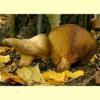
images/Paxillus_involutus/Paxillus_involutus.jpg
Medium to large agaric, growing on the ground, with a rusty to ochre-brown or clay-brown spore print. Pileus becoming infundibuliform, brown, viscid when fresh, initially with a fimbriate margin. Lamellae brown, bruising brown, subdecurrent or decurrent, forked and with anastomoses near the stipe. Stipe central or excentric. Partial veil remnants absent. Spores pale or yellow-brown, non-amyloid, smooth; germ pore absent. Cheilocystidia present. Lamellar trama regular or bilateral. Pileipellis a cutis or a trichoderm. Clamp connections present.
Very close to
Austropaxillus, differing in the association with exotic trees, in having ellipsoid (rather than elongate) spores, and in the constant presence of pleurocystidia (which can be absent in
Austropaxillus).
Phylloporus is also similar, but it usually has bright yellow lamellae, often bruises red, green or blue, and lacks clamp connections. The brown spore print and the smooth and rounded non-amyloid spores distinguish this from other robust agarics with decurrent lamellae such as
Lepista,
Leucopaxillus,
Clitopilus morphogroup Rhodocybe and
Russula.
Paxillus Fr., Fl. Scan. 339 (1836).
One species: Paxillus involutus.
Paxillus involutus (Batsch : Fr.) Fr., Epicr. Syst. Mycol. 317 (1838).
W.A., S.A., N.S.W., Vic. and Tas.
In gardens, only under exotic trees (birch, oak and poplar, also occasionally conifers such as pine and larch).
On the ground.
Ectomycorrhizal.
Bougher, N.L. (2009a),
Fungi of the Perth region and beyond: a self-managed field book, Western Australian Naturalists' Club (Inc.), Perth. [
Description and
Illustration of
P. involutus]
Breitenbach, J. & Kränzlin, F. (eds) (1991), Fungi of Switzerland. Volume 3. Boletes and Agarics 1s part. Edition Mykologia, Lucerne. [Illustration, Description and Microcharacters of P. involutus from Europe]
Fuhrer, B. (2005), A Field Guide to Australian Fungi. Bloomings Books, Hawthorn. [Description and Illustration of P. involutus]
Grgurinovic, C.A. (1997a), Larger Fungi of South Australia. The Botanic Gardens of Adelaide and State Herbarium and The Flora and Fauna of South Australia Handbooks Committee, Adelaide. [Description, Illustration and Microcharacters of P. involutus]
McCann, I.R. (2003), Australian Fungi Illustrated. Macdown Productions, Vermont. [Illustration of P. involutus]
McNabb, R.F.R. (1969), The Paxillaceae of New Zealand, New Zealand J. Bot. 7: 349–362. [Description and Microcharacters of P. involutus from New Zealand]
Watling, R. & Gregory, N.M. (1991), Observations on the boletes of the Cooloola sandmass, Queensland and notes on their distribution in Australia. - Part 3: lamellate taxa, Edinburgh J. Bot. 48: 353–391. [Comments on P. involutus in Australia]
Watling, R. & Li, T.-H. (1999), Further observations on the boletes of the Cooloola Sandmass, Queensland and extralimital area, in R.Watling & T.-H.Li, Australian Boletes: a Preliminary Survey, 27–71. Royal Botanic Garden, Edinburgh. [Description and Microcharacters of P. involutus]
Young, A.M. (2005b), A Field Guide to the Fungi of Australia. University of New South Wales Press, Sydney. [Description and B&W Illustration of P. involutus]



_AH_01_sml.jpg)
